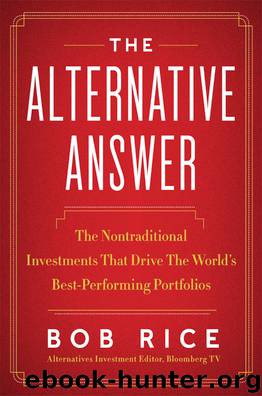The Alternative Answer by Bob Rice

Author:Bob Rice
Language: eng
Format: epub
Publisher: HarperCollins
Venture Funds
Venture capital funds are like basketball: a true American invention. The blend of risk capital, expertise, and ferocious entrepreneurial spirit could only have been born here. (George W. Bush may have gone slightly overboard on the point when he famously claimed that the French have no word for entrepreneur, but you know what he meant.) Applied to the fertile ground of technology innovation, it has produced countless world-changing companies. In a perfect world, that should generate gargantuan profits; even in our very imperfect one, it does.
Those opportunities continue to abound; certainly, the pace of revolutionary changes isn’t slowing down any. Robotics and 3D printing are poised for their glory days (did you know that Bond’s Aston Martin in Skyfall, blown up at the end, was a replica made with a 3D printer? That’s why they could afford to shoot the scene repeatedly). Mobile devices, the cloud, and voice recognition will profoundly alter the ways in which we use computers. Two massive industries, education and health care, are already reinventing themselves to exploit technology to reduce costs; others will follow. Global Internet penetration will continue to skyrocket, and transactional dollar volumes will follow as the rest of the world cultures become more comfortable with providing sensitive information online and as nonbank payment systems become ever more available.
Meantime, though, the number of dollars raised by venture capital firms has been falling for several years (to about $18 billion in 2011 from over $30 billion in 2007). That’s a good thing if you can get your money to work in the right deals, since it clearly means more opportunities at better prices. Equally important, an excellent exit path, much more reliable than the traditional IPO, has emerged of late: an enormous herd of strategic buyers. As large companies build huge cash war chests, but slash R&D spending, they’re essentially forced to go out shopping for important innovations. In the ’80s, about nine out of ten exits were IPOs, and just 10% were through merger transaction; today, that ratio is almost exactly reversed.
The downside of investing in venture funds is pretty simple: many don’t do so well. Study after study indicates that the top 10% of funds generate a hugely disproportionate share of the entire industry’s returns, and that many funds in the bottom half of performance statistics have failed to return all of their investors’ dollars. There’s a pretty clear reason: deal flow. Nothing succeeds like success, and entrepreneurs very much want to work with the VC firms that have big wins on their belts. The same is true even with the numerous new seed-stage funds, which are making smaller bets faster than their more established cousins . . . a few top-tier funds have emerged very quickly.
It’s pretty easy to find those top performers, but they’re not taking new capital from strangers, so don’t bother to call. Obviously nothing says previously poorly performing funds, or new ones, won’t do just fine, but figuring out which ones are good bets probably requires a pretty high level of expertise in the space.
Download
This site does not store any files on its server. We only index and link to content provided by other sites. Please contact the content providers to delete copyright contents if any and email us, we'll remove relevant links or contents immediately.
| Analysis & Strategy | Bonds |
| Commodities | Derivatives |
| Futures | Introduction |
| Mutual Funds | Online Trading |
| Options | Portfolio Management |
| Real Estate | Stocks |
Rich Dad Poor Dad by Robert T. Kiyosaki(6414)
Pioneering Portfolio Management by David F. Swensen(6231)
How To Win Friends and Influence People by Dale Carnegie(4449)
The Money Culture by Michael Lewis(4083)
The Dhandho Investor by Mohnish Pabrai(3706)
The Wisdom of Finance by Mihir Desai(3659)
Liar's Poker by Michael Lewis(3372)
Fooled by Randomness: The Hidden Role of Chance in Life and in the Markets by Nassim Nicholas Taleb(3050)
The ONE Thing by Gary Keller(3015)
The Intelligent Investor by Benjamin Graham Jason Zweig(2997)
Mastering Bitcoin: Programming the Open Blockchain by Andreas M. Antonopoulos(2986)
Rich Dad Poor Dad: What The Rich Teach Their Kids About Money - That The Poor And Middle Class Do Not! by Robert T. Kiyosaki(2910)
How to Day Trade for a Living: Tools, Tactics, Money Management, Discipline and Trading Psychology by Andrew Aziz(2909)
Investing For Dummies by Eric Tyson(2895)
How to Win Friends and Influence People by Dale Carnegie(2865)
Market Wizards by Jack D. Schwager(2645)
The Psychology of Money by Morgan Housel(2635)
Zero Hour by Harry S. Dent Jr. & Andrew Pancholi(2614)
How to Pay Zero Taxes, 2018 by Jeff A. Schnepper(2604)
